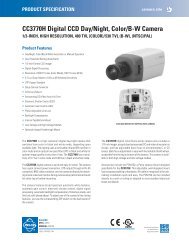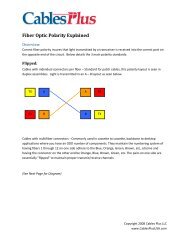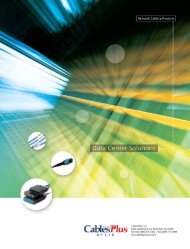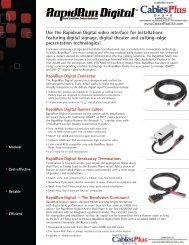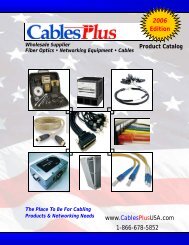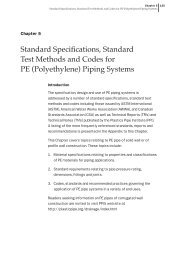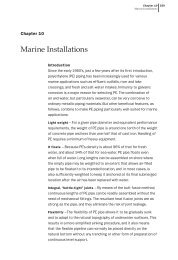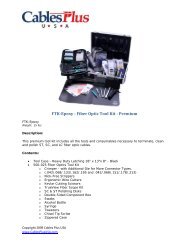Learning About Options in Fiber - Cables Plus USA
Learning About Options in Fiber - Cables Plus USA
Learning About Options in Fiber - Cables Plus USA
You also want an ePaper? Increase the reach of your titles
YUMPU automatically turns print PDFs into web optimized ePapers that Google loves.
eak due to the curvature of the fiber.<br />
• Plac<strong>in</strong>g the fiber <strong>in</strong> a horizontal fixture where<br />
the blade will scratch the fiber and the tension<br />
is applied from the end of the fiber pull<strong>in</strong>g the<br />
fiber from the scribed location.<br />
SECTION 2—FIBER-OPTIC BASICS<br />
Figure 2-25— Connector Types<br />
Biconic<br />
• Us<strong>in</strong>g a tool which scribes the entire circumference<br />
of the fiber, and then pull<strong>in</strong>g from the<br />
ends of the fiber.<br />
• Us<strong>in</strong>g a hand scribe or pen scribe where the<br />
fiber is placed <strong>in</strong> the hand or fixture and the<br />
operator draws the scribe tool across the fiber.<br />
After the scribe, the operator breaks the fiber<br />
off by tugg<strong>in</strong>g with his hand.<br />
Even with the best tools and operator experience, the<br />
cleave, scribe, or break can be <strong>in</strong>adequate. Because<br />
of this, the end of the cleaved fiber should always be<br />
<strong>in</strong>spected carefully with a field microscope.<br />
Upon <strong>in</strong>spection, the splicer should look for nice<br />
perpendicular end face to the axis of the fiber. No<br />
“lips” where the fiber edge is exposed or “hackle”<br />
where the fiber has broken away from the fiber. The<br />
fiber should have a good clean end face free of<br />
cracks, chips, and scratches. The angle of the fiber<br />
should not be visible. If any of these conditions can<br />
be seen, the cleav<strong>in</strong>g cycle should be repeated.<br />
Polish<strong>in</strong>g<br />
Polish<strong>in</strong>g is done <strong>in</strong> two or more steps with <strong>in</strong>creas<strong>in</strong>gly<br />
f<strong>in</strong>er polish<strong>in</strong>g grits. Wet polish<strong>in</strong>g is recommended,<br />
preferably us<strong>in</strong>g water, which not only<br />
lubricates and cools the fiber, but also flushes<br />
polish remnants away. The connector and fiber<br />
face should be cleaned before switch<strong>in</strong>g to a f<strong>in</strong>er<br />
polish<strong>in</strong>g material.<br />
Polish<strong>in</strong>g has a second function: It gr<strong>in</strong>ds the connector<br />
tip to a precise dimension. This dimension<br />
controls the depth that the connector tip and fiber<br />
extend <strong>in</strong>to the bush<strong>in</strong>g that holds the two connectors.<br />
It thereby controls the gap between mated<br />
fibers. If the tip dimension is too long, the mated<br />
fibers may be damaged when they are brought<br />
together. If the dimension is too short, the gap<br />
may be large enough to produce unacceptable<br />
losses.<br />
The first polish<strong>in</strong>g steps gr<strong>in</strong>d the connector tip<br />
and fiber to the correct dimension. The f<strong>in</strong>al step<br />
ST Type<br />
SMA 906<br />
polishes the fiber face to a mirrorlike f<strong>in</strong>ish.<br />
As with cleaved fiber, polished fiber should be<br />
<strong>in</strong>spected under a microscope. Small scratches<br />
on the fiber face are usually acceptable, as are<br />
small pits on the outside rim of the cladd<strong>in</strong>g, Large<br />
scratches, pits <strong>in</strong> the core region, and fractures<br />
are unacceptable.<br />
Some poor f<strong>in</strong>ishes, such as scratches, can be<br />
remedied with additional polish<strong>in</strong>g. Fractures and<br />
pits, however, usually mean a new connector must<br />
be <strong>in</strong>stalled.<br />
CONNECTOR ASSEMBLY<br />
Ideally one connector type will be used throughout<br />
your system or network for ease of test<strong>in</strong>g, ma<strong>in</strong>tenance,<br />
and adm<strong>in</strong>istration. The most common<br />
connectors found are biconic, ST type and SMA.<br />
See Figure 2-25 show<strong>in</strong>g these connector types.<br />
Biconic Connectors<br />
Available <strong>in</strong> both s<strong>in</strong>gle- and multimode versions,<br />
the biconic is a small size connector with screw<br />
thread, cap, and spr<strong>in</strong>g-loaded latch<strong>in</strong>g mechanism.<br />
Its advantages are low <strong>in</strong>sertion and return<br />
loss and that it is very common with manufacturers<br />
and telephone companies. Its disadvantages are<br />
2-23



